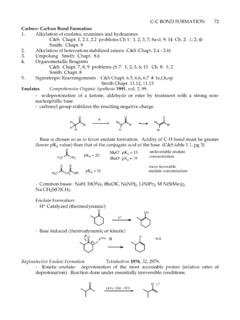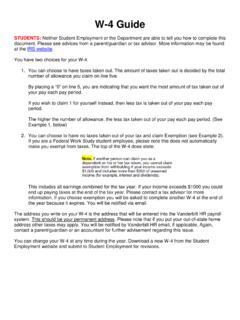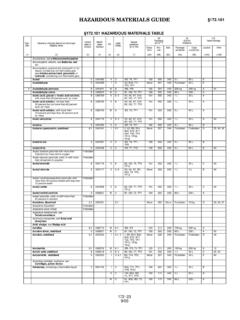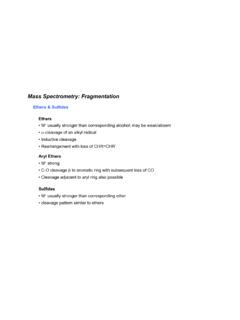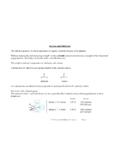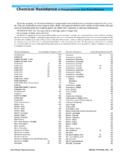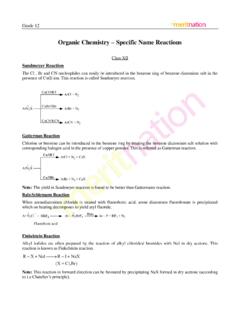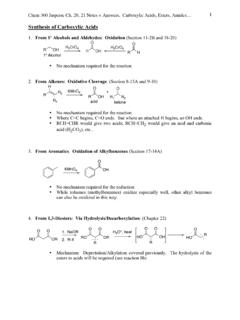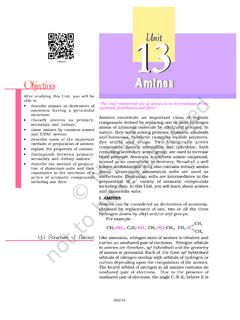Transcription of Chapter 7: Alkenes: Reactions and Synthesis
1 1 Chapter 7: Alkenes: Reactions and SynthesisCCCCOHHCCHHCCOHXCCXX alcoholalkanehalohydrin1,2-dihalideCCXH halidealkeneCCOHHO1,2-diolCChalideCCOcar bonylCCalkeneXY+CCYXE liminationAdditionElectrophilic AdditionDehydrohalogenation: loss of HX from an alkyl halide to form an alkene+ HBrBrHHHHH etherBrHHH+ KOHEtOH(ethanol)HH+ KBr + H2O2 Hydration: addition of water (H-OH) across a double bond togive an alcoholDehydration: Loss of water (H-OH) from an alcohol to give analkene+ H2 OOHHHHHHH+OHHHHHH+ H2OH+Addition of Halogens (X2) to Alkenes: 1,2-dihalidesCCCCXX1,2-dihalidealkeneX21 ,2-dibromide has the anti stereochemistryBromonium ion intermediate controls the stereochemistry+ Br2 BrBr+BrBrnot observed3 Halohydrin FormationCCCCOHX halohydrinalkene"X-OH"XOHantistereochemi stryBr2, H2O+ HBrOrganic molecules are sparingly soluble in water as solvent. The reaction is often done in a mix of organic solvent and water using N-bromosuccinimide (NBS) as the electrophilic bromine , H2 ONOOBr+BrOHNOOH+Note that the aryl ring does not react!
2 !!For unsymmterical alkenes, halohydrin formation is Markovnikov-like in that the orientation of the addition of X-OH can be predicted by considering carbocation stabilitymore d+ charge on themore substituted carbonBr adds to the double bond first (formation of bromonium ion) and is on the least substituted end of the double bondH2O adds in the second step and adds to thecarbon that has the most d+ charge and endsup on the more substituted end of the double bondCH3Br d+d+d+CH3Br2, H2 OCH3 HOBrH4 Hydration of Alkenes: addition of water (H-OH) across the p-bondof an alkene to give an catalyzed hydration- Markovnikov addition of H-OHNot a good method for hydration of an Markovnikov addition Anti-Markovnikov addition of H-OH, Syn addition of H-OHCH31) Hg(OAc)2, H2O2) NaBH4CH3 HOHHCH31) B2H6, THF2) H2O2, NaOH, H2 OCH3 HHHOBHBHHHHHB2H6 (diborane)Otetrahydrofuran(THF)2OH3B+_bo rane-THFcomplex5 Reaction of Alkenes with Carbenes to give CyclopropanesCarbene: highly reactive, 6-electron species.
3 (sp2-hybridized)Generation and Reaction of Carbenes:CHCl3 + KOH Cl2C: + H2O + KCldichlorocarbeneCH2I2 + Zn(Cu)etherI-CH2-Zn-I = H2C: Simmons-Smith Reaction (cyclopropanation)methylenecarbeneCHCl3, KOHClClHHCH2I2, Zn(Cu)HHether6 The cyclopropanation reaction of an alkene with a carbene takes placein a single step. There is NO intermediate. As such, the geometry of the alkene is preserved in the product. Groups that are trans on the alkene will end up trans on the cyclopropane product. Groups that are cis on the alkene will endup cis on the cyclopropane , Zn(Cu)etherHHRRcis-cyclopropaneHRRH trans-alkeneCH2I2, Zn(Cu)etherHRRH trans-cyclopropaneHydrogenation: Addition of H2 across the p-bond of an alkene to give an alkane. This is a reduction. The reaction uses H2 and a precious metal catalyst. The catalysts is not soluble in the reaction media, thus this process is referred to as a heterogenous catalysis.
4 The catalyst assists in breaking the p-bond of the alkene and the H-H s-bond. The reaction takes places on the surface of the catalyst. Thus, the rate of the reaction is proportional to the surface area of the catalyst. To increase the surface area of the catalyst it is finely dispersed on an inert support such as charcoal (carbon, C) Carbon-carbon p-bond of alkenes and alkynes can be reduced to the corresponding saturated C-C bond. Other p-bond bond such as C=O (carbonyl) and C N are not easily reduced by catalytic hydrogenation. The C=C bonds of aryl rings are not easily , PtO2ethanol7 Catalysts: Pt2O (Adam s catalyst) or Pd/C mechanism:The addition of H2 across the p-bond is syn H2, PtO2ethanolOOOCH3OH2, Pd/CethanolOCH3 OCNCNH2, Pd/CethanolH2, PtO2ethanolCH3CH3CH3CH3 HHsyn additionof H2CH3 HHCH3 Not observedC5H11 OHOL inoleic Acid (unsaturated fatty acid)H2, Pd/CCH3(CH2)16CO2 HSteric Acid (saturated fatty acid)8 Oxidation of Alkenes to 1,2-Diols and CarbonylHydroxylation: formal addition of HO-OH across the p-bond of analkene to give a 1,2-diol.
5 This is an overall oxidation. 1) OsO42) NaHSO3 OHOHHHsyn addition HHOOsOOOosmate ester intermediate - not usually isolate - NaHSO3 breaks down the osmate ester to the productOzonolysis: oxidative cleavage of an alkene to carbonyl p- and s-bonds of the alkene are broken and replaced withC=O doubled bonds. C=C of aryl rings, C N and C=O do not react with ozone, C C react very slowly with ozone3 O2 2 O3electricaldischargeOzone (O3):OOO_+R2R1R3R4O3, CH2Cl2-78 COOOR1R2R4R3 OOOR1R2R4R3molozonideozonideZnR1R2OR4R3O ++ ZnO91) O32) ZnOO+1) O32) ZnHOO1) O32) ZnHO+ O=CH2 Oxidative Cleavage of 1,2-Diols to Carbonyl CompoundsOHHOR1R2R4R3R1R2OR4R3O++ ZnONaIO4 THF, H2 OOIOR1R2R4R3 OOOH periodate intermediateOHHHOOOHNaIO4
